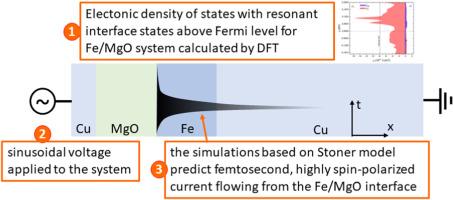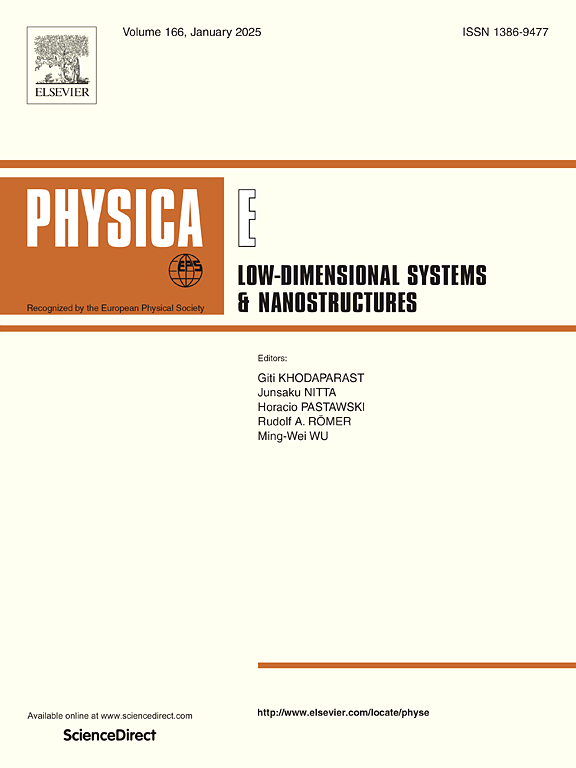利用准静态电压在铁/氧化镁界面上产生飞秒自旋极化电流脉冲
IF 2.9
3区 物理与天体物理
Q3 NANOSCIENCE & NANOTECHNOLOGY
Physica E-low-dimensional Systems & Nanostructures
Pub Date : 2024-10-03
DOI:10.1016/j.physe.2024.116120
引用次数: 0
摘要
短自旋电流脉冲的产生对快速自旋电子设备至关重要。迄今为止,自旋电流脉冲是由飞秒激光脉冲产生的,飞秒激光脉冲从铁磁性金属层驱动自旋。然而,由于对微型化、简便性和能效的需求,自旋电子器件的电场控制优于光学或热控制。在这里,我们将氧化镁/铁界面电子态密度的 ab initio 计算与电荷传输连续模型相结合,研究了自旋相关电势的动态。我们证明,由于氧化镁/铁界面上的电子共振态,电压驱动的电子能带结构的不稳定性导致产生飞秒自旋极化电流脉冲,其自旋极化高达 P=7 00 %,并从界面传播到主体。斯通纳不稳定性驱动的电流脉冲的动态既不取决于介电弛豫时间,也不取决于如何通过改变电压实现不稳定性的细节,也就是说,只要电压变化相对于自旋扩散常数决定的时间是缓慢的(准静态),即在 fs 量级。不稳定性的存在可以通过太赫兹时域光谱或泵浦探针技术检测到。本文章由计算机程序翻译,如有差异,请以英文原文为准。

Generation of femtosecond spin-polarized current pulses at Fe/MgO interface by quasi-static voltage
The generation of short spin-current pulses is essential for fast spintronic devices. So far, spin current pulses are generated by femtosecond laser pulses which drive spins from a ferromagnetic metal layer. However, the need for miniaturization, simplicity and energy efficiency favour electric-field control of spintronic devices over optic or thermal control. Here, we combine ab initio calculations of electronic density of states at MgO/Fe interface with continuous model for charge transport to investigate the dynamics of the spin-dependent potential. We demonstrate that the voltage-driven instability of the electronic band structure due to the electronic resonant states at the Fe/MgO interface results in the generation of the femtosecond spin-polarized current pulse with the spin polarization up to 00 % that propagates from the interface to the bulk. The dynamics of the current pulses driven by the Stoner instability depends neither on the dielectric relaxation time nor on the details of how the instability is achieved by changing the voltage, i.e. as long as the voltage changes are slow (quasi-static) with respect to the time determined by the spin diffusion constant, being of the order of fs. The presence of the instability can be detected by THz time-domain spectroscopy or pump-probe techniques.
求助全文
通过发布文献求助,成功后即可免费获取论文全文。
去求助
来源期刊
CiteScore
7.30
自引率
6.10%
发文量
356
审稿时长
65 days
期刊介绍:
Physica E: Low-dimensional systems and nanostructures contains papers and invited review articles on the fundamental and applied aspects of physics in low-dimensional electron systems, in semiconductor heterostructures, oxide interfaces, quantum wells and superlattices, quantum wires and dots, novel quantum states of matter such as topological insulators, and Weyl semimetals.
Both theoretical and experimental contributions are invited. Topics suitable for publication in this journal include spin related phenomena, optical and transport properties, many-body effects, integer and fractional quantum Hall effects, quantum spin Hall effect, single electron effects and devices, Majorana fermions, and other novel phenomena.
Keywords:
• topological insulators/superconductors, majorana fermions, Wyel semimetals;
• quantum and neuromorphic computing/quantum information physics and devices based on low dimensional systems;
• layered superconductivity, low dimensional systems with superconducting proximity effect;
• 2D materials such as transition metal dichalcogenides;
• oxide heterostructures including ZnO, SrTiO3 etc;
• carbon nanostructures (graphene, carbon nanotubes, diamond NV center, etc.)
• quantum wells and superlattices;
• quantum Hall effect, quantum spin Hall effect, quantum anomalous Hall effect;
• optical- and phonons-related phenomena;
• magnetic-semiconductor structures;
• charge/spin-, magnon-, skyrmion-, Cooper pair- and majorana fermion- transport and tunneling;
• ultra-fast nonlinear optical phenomena;
• novel devices and applications (such as high performance sensor, solar cell, etc);
• novel growth and fabrication techniques for nanostructures

 求助内容:
求助内容: 应助结果提醒方式:
应助结果提醒方式:


